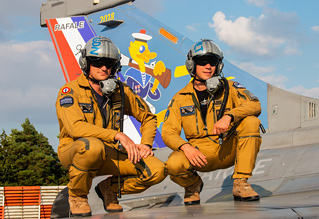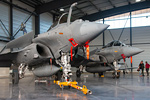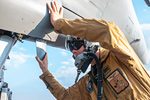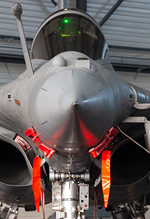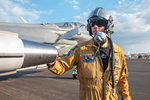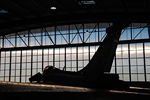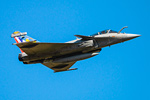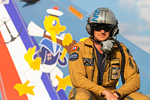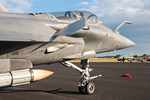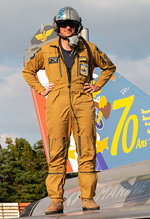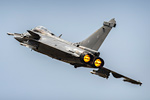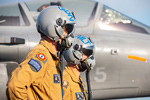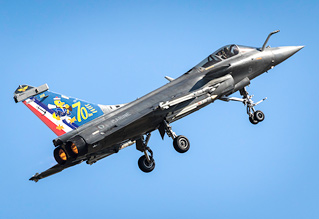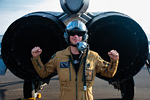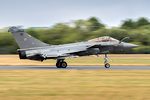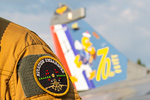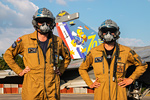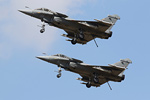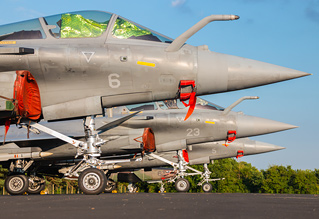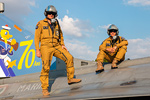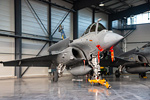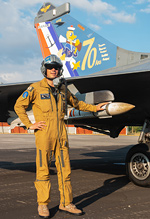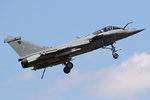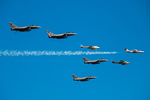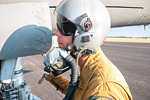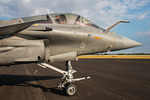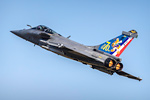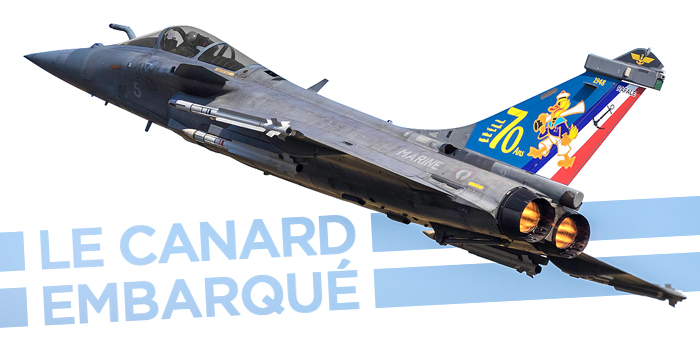
French Navy Rafale Pilots Interview
Saturday 14th July 2018
One of the most anticipated acts that attended the Royal International Air Tattoo this year was the two-ship Rafale M display sent by the Aeronavale, the air arm of the French Navy. It marked the Navy’s first attendance at the show in a number of years, and their first flying display in considerably longer when a Falcon 10MER attended in 2003. With such an enormous gap in participation it was fantastic to see the Aeronavale’s fighter wing, the Chasse Embarquée commit to RIAT so strongly.
and caught up with Flottille 12F pilots LV "Briz" and CC "Dingo" to chat about French naval aviation and displaying at RIAT. Photography by the UKAR Staff Team.
UKAR last spoke to LV "Briz" at La Ferté-Alais in May, when he was part of the four-ship Rafale M demo that displayed at that show - at RIAT, he was the flight lead for the display and has been responsible for building up the pairs routine. "Briz", who has been flying the Rafale M in the Aeronavale since 2012, was also part of the display team that performed at La Ferté-Alais in 2016. In his 1100 hours on the type, he has taken part in combat missions over Syria and Iraq and accrued 300 carrier traps, nearly a third of which were at night. Consequently, he’s a pilot very well experienced to perform jet displays - but he insists that the routine flown at RIAT can be performed by any jet pilot in the French Navy:
“We wanted to provide to everybody a tactical display since we don’t have a full-time team dedicated to it, so the design of this display is to be easily made by any French pilots in the Navy. That actually means we only need about two simulator rehearsals and one practice flight and after that you’re good to go as it’s only manoeuvres you practice every day. We just have to combine it in a proper way but it’s not that big of a challenge for us.”
For "Dingo", who has never displayed before, this has helped immensely, but one thing has stood out: “The only thing different is that you have to perform in front of a large crowd, so we brief in advance of that so as not to be affected by stage fright.” "Briz" goes further on this point: “That’s the major issue, actually, displaying in front of the crowd and feeling the emotion. It’s impressive, and we don’t want people to be overwhelmed by that feeling as it can have bad consequences so you have to keep your head cool. But that feeling is something really interesting to experience.” "Dingo", like "Briz", has been flying the Rafale for some time (since 2010 - in fact, his fast jet career in the Aeronavale has been entirely on the Rafale M whereas "Briz" has 400 hours on the Super Étendard Modernisé), and has plenty of experience under his belt, but it’s really interesting to hear seasoned combat pilots discuss so openly the factor of stage fright in front of a crowd - probably not something that most people would think would be a concern for those that reach the heights of fighter pilot, and a strong reminder that display flying for our entertainment is not an easy or risk-free task.
Experience gained through live displays is a huge help, of course, and 12F have been at the forefront of French naval aviation demonstration at airshows this year. 2018 marks the squadron’s 70th anniversary as commemorated on one of the attending jet’s tail which is part of the reason that they were chosen to display at RIAT, Europe’s largest air display stage. In fact, the last time the Aeronavale displayed fighters at Fairford was 1999 when they performed with two F-8 Crusaders from Flottille 12F - only two years later the same squadron received Rafale Ms, becoming the first squadron in France to take on the Rafale. Quite the step up in capability, from a jet that first flew in 1955 straight to one of the world’s most advanced “omnirole” jets but fitting that it should be this pioneering squadron that returned to display as a result.
However, the Aeronavale keeps itself busy. Flottille 17F deployed to the USA earlier this year for Operation Chesapeake 2018 where they operated their Rafale Ms off of the US Navy’s Nimitz-class carrier USS George H W Bush, while the French Navy’s sole carrier, the Charles de Gaulle, has been undergoing mid-life refit and post-refit trials. As for "Briz" and "Dingo", training and preparation for their displays has had to be balanced with operational work. As such, the French Navy simply won’t have a full-time display demo like the Air Force does as it would take away resources and people too much. “That’s not going to happen,” "Briz" explains, “We’re more focused on operations and using the aircraft for what it’s made for and taking part in these displays is something we can do sometimes if we’re available. If we have the manpower and resources to do the four-ship display at major events, we will! But we won’t be creating one team for it.”
"Dingo" expanded: “Our goal when we do it is to teach the new generation about the French Navy and are inspired. Our job requires excellence and we want to communicate that.” So what does it take to achieve that excellence and become a fighter pilot in the Aeronavale? The selection process can begin after high school - a degree isn’t a requirement to fly in the French Navy - and after light aircraft training those pilots who show enough promise to be streamed onto fast jets will travel to the US to complete the US Navy jet training syllabus on the T-45C Goshawk. This 15 to 20 month element not only covers basic fighter manoeuvres, jet handling and weaponry deployment but also the obviously crucial task of flying off an aircraft carrier, as well as sea survival skills and learning English, a requirement for NATO pilots.
All very daunting, but the pilots insist that no one should be put off from applying: “You have to be patient, work hard but it’s worth the cost. You have to give it a try. There are too many people that will say it’s impossible - but no, we can’t listen to those people that will say you can’t do it, just do it, give it a try and have faith in yourself. If you have the will to do it, you will succeed, definitely, as long as your physical capabilities are good. People have to know that when you’ve finished high school you can apply to fly in the Navy, you don’t need a degree because all you need to know how to do in the air is add, subtract, multiply and divide, that’s it! If you know all that, you’re good to go, I swear. We want simple ideas in the aeroplane, stuff that really works. That’s the kind of people we’re looking for. ” Following the Advanced Jet Training with the USN pilots go straight onto the Rafale M - they might be put onto extra training in one of the Air Force’s Rafale B twin-stick trainers but it’s not compulsory as all the essential skills have already been taught and developed, eradicating the stress of jumping straight into solo fighter jet action.
Even the youngest of the new French generation who might be inspired to fly the Rafale M can expect to have a chance as both the type and the carrier it flies off has at least another couple of decades of service planned, with the Rafale OSD likely to be between 2035 and 2040. Earlier this year a big step was already taken towards France’s next fighter that will eventually replace the Rafale as Dassault and Airbus announced a partnership on the Future Combat Air System (FCAS); a few months later, BAE announced their own future project in the BAE Tempest. The FCAS, as well as replacing Germany’s Eurofighters, will feature a conventional system and maritime system similar to the Rafale that will operate off the Charles de Gaulle’s successor, which should be in place around a similar time.
Fulfilling what "Briz" promised back at La Ferté, the display was performed with weaponry on the aircraft pylons, adding an edge to the display over the other flying participants. Fairford is no stranger to “tooled up” displays but there was something quite sleek about the air interception loadout with two MICA IR and two MICA EM missiles on each aircraft, and where similar displays such as the BAE Systems Typhoon demo might seek to show the capabilities of the jet at maximum combat weight this configuration didn’t impact the demo. While some air-to-ground configurations require the Rafale’s flight control system to force a lower “g”-limit, an all air-to-air configuration doesn’t impact the aeroplane’s limits as the missiles don’t add that much drag and their “g”-limits are much higher than the aircraft’s own or indeed those of the pilot operating them.
As with all display pilots, not only are they tasked with putting on an exciting display for airshow crowds but also to act as representatives and ambassadors for their country at home and abroad. When asked how they have taken this on, "Dingo" actually said that it’s not an unfamiliar role: “We’re really proud to represent France. We do it very often when we’re with the ship abroad, in a port of call, so it’s part of our mission to represent France abroad. It’s our pleasure to do it.” As for their appearance in the UK, "Briz" summed up their experience at the world’s largest military airshow: “There is a great sharing between all the nations. RIAT have done a great job planning the events, the organisation is very strong and we can feel it, and it’s mainly because of the really strong planification stages we can enjoy it. All the volunteers are really dedicated to helping us! We’ve had a great time and really enjoyed displaying here.”
2018 saw superb participation by the Aeronavale at British airshows, sadly marred by the cancellation of the extremely rare ATL2 display from both Yeovilton and RIAT, the latter coming after the aircraft had already rehearsed at the show. Without a doubt the Chassé Embarquée’s strong airshow efforts this year at home and abroad despite their busy operational scheduling has brought French naval aviation to the forefront of people’s minds and strengthened the already close ties between the British and French militaries as well. Most hope that it will not be another five years before they decided to attend the Air Tattoo again, but until they do they will continue to demonstrate their excellence around the world where they can.
UKAR would like to thank the RIAT Media Liaison Group for their assistance in interviewing and photographing "Briz" and "Dingo".
